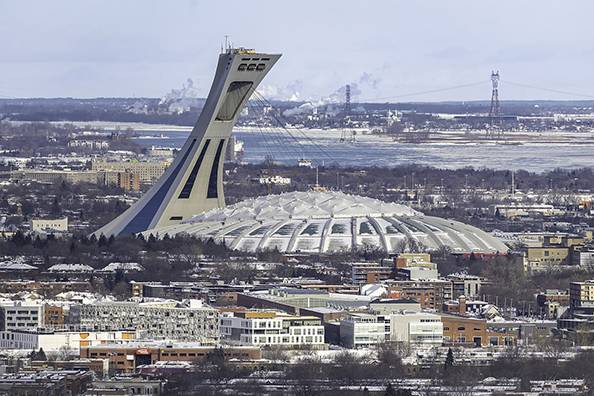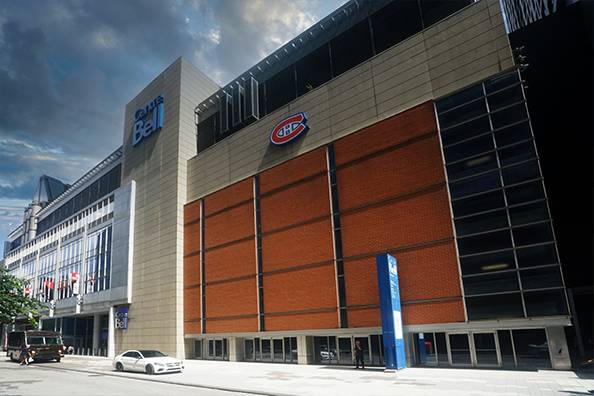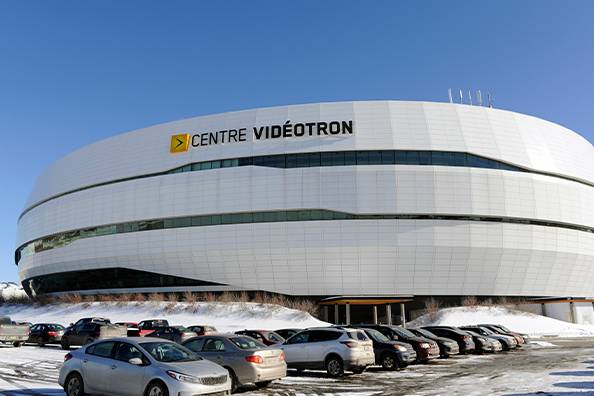Two Montréal landmarks have proudly hosted some of the city’s most memorable sporting events. The Olympic Stadium (Figure 1) and the IGA Stadium, which have been and remain quintessential in our sporting history, are in need of renovations so that sports fans can continue to “raise the roof” for years to come.

Figure 1: The Olympic Stadium: A prominent feature of the Montréal skyline.
These stadiums may be iconic, but the issues with their roofing systems—or lack thereof—have plagued the Montréal news for over 30 years. It is estimated that installing a retractable roof over the centre court at IGA stadium could cost $70 million, and replacing the Olympic Stadium’s roof and support ring, no less than $870 million.1 These projects may be considered priorities,2 but the skyrocketing construction and renovation costs are already causing a stir.3 And to make matters worse, the problem will not be solved definitively, as the lifespan of the new Olympic Stadium roof is estimated at 50 years.4
These projects are just the tip of the iceberg when it comes to our sports infrastructure. According to the Minister responsible for Sport, Recreation and Outdoors, Isabelle Charest, “This is a huge endeavour. A good part of the infrastructure could use some work and revamping. And in some cases, we need new infrastructure, period.”5 In other words, the needs are varied and many. Investing in charming small, local skating rinks, multi-purpose municipal sports facilities and even towering stadiums used by professional sports leagues is essential to fostering physical well-being and keeping the population healthy ... or simply entertained.
Mindful of the importance of physical activity as well as voters’ appreciation for sports, the Quebec government invested $300 million in the Programme d’aide financière aux infrastructures récréatives, sportives et de plein air (PAFIRSPA, financial aid program for recreational, sporting and outdoor activity infrastructure).6 One component of this program provides financing for up to two-thirds of the cost of renovating, upgrading, building or developing sports and recreational facilities, up to a maximum amount of $20 million per project. Applicants seeking financing from the program had to submit their applications by December 5, 2023.
While the PAFIRSPA may seem ambitious, the projects it covers are obviously far less expensive than modern professional sports arenas, which have become true engineering and technological marvels over the years. The cost of building Tottenham Hotspur Stadium in London in 2019, for instance, has been estimated at £1.1 billion,7 which itself is a pittance compared to the US$5.5 billion needed to build the SoFi Stadium in Los Angeles, where the football teams Rams and the Chargers have been playing since 2023.8
As in most situations, money matters when it comes to sports infrastructure. A winning financing strategy is not everything—it’s the only thing. In this first instalment of our series of articles on sports law, we will focus on sports infrastructure financing and examine what lies beneath the surface, as we begin to uncover the challenges, strategies and issues.
The Rules of the Game
Sports infrastructure financing lies at the crossroads of the entertainment business and the public interest, and it differs from other types of financing in a number of ways. On one hand, the public’s ever-growing appetite for sporting events over the years has spawned numerous colossal projects requiring financing packages similar to those for public or industrial infrastructure projects of the same scale. On the other, the economic benefits and social impact of projects of various sizes often warrant the use of public funds, and the involvement of local communities may be imperative in the case of facilities where utility takes precedence over profitability.
In addition, a wide range of financing mechanisms can be used, depending not only on the sums involved, but also on the identity of the infrastructure owners. For the purposes of this article, we will consider financing in relation to three types of ownership: (i) wholly private, (ii) public and private, and (iii) wholly public. We will be taking a closer look at specific financing options and associated issues in our next sports law article.
Wholly Private Ownership Financing
This refers to infrastructure owned by a private entity and operated by a private administrator, which may or may not be the same entity.
One example is the Bell Centre (Figure 3), privately owned by Groupe CH, which is in turn owned by the Molson family and other investors.

Figure 3: The 2022 National Hockey League Draft was held at the Bell Centre.
This type of ownership usually involves wholly private financing, with the owner injecting the funds required to carry out the desired work. According to media reports, the owner of the Bell Centre invested $100 million in 2015 to renovate it.9 This amount came from Groupe CH and its investors alone.
Needless to say, with this type of ownership, any kind of financing is possible, including shareholder equity investment, the issuance of bonds to private subscribers and all forms of bank debt. Combining several of these options is not at all uncommon.
In the case of debt financing in particular, making lenders feel as comfortable as possible can be a challenge, and the magnitude of this challenge will depend on the amounts involved. Just how profitable a project will be hinges on whether it can be completed at the agreed-upon cost and whether it will be a commercial success once completed. Generally speaking, using a project’s assets as collateral will not be enough to get lenders on board, and they will require other forms of security, such as shareholder guarantees, fixed-price or capped construction contracts, or the involvement of subordinated lenders. When economic spinoffs are expected to benefit the community, public authorities can also be called upon to guarantee part of the loan repayment or offer various forms of public funding, including forgivable loans, thus reducing the risk assumed by lenders. Efforts to reduce the risk incurred by lenders should, in theory, result in significantly lower financial costs, or in some cases, in obtaining the required financing.
Other projects rely on government procurement. Olympique Lyonnais became the first French professional soccer club to be listed on the stock exchange in 2007, when the club’s shares were put up for sale on the Euronext market in Paris. The funds raised in this way were put towards the club’s development projects, including the financing of its new stadium, which opened in January 2016. This financing package consisted of a combination of equity (including proceeds from stock issues), bank loans, traditional bonds and mandatory convertibles.10
Other supplementary yet substantial financing arrangements, such as naming rights agreements, may be used to enhance financing packages. Under such an agreement, a company can acquire naming rights to an arena for a predetermined period, generally between 3 and 20 years, in consideration of a substantial sum of money. In 2017, Scotiabank agreed to pay $800 million over 20 years to rename the building that houses the Toronto Maple Leafs hockey club the “Scotiabank Arena.”11 In addition to renaming facilities, it is possible to sell perimeter advertising or solicit individual donors to purchase a plaque bearing their name at the entrance to a field, in rows or in the bleachers.
Read our latest bulletin on this topic
Promoters’ financial models are routinely enhanced by other creative revenue streams, including catering concessions, box rental agreements or preferred memberships, parking spaces, boutiques and advertising. Other sources of income include leasing agreements for various uses of the facilities. Some manufacturers in the sports field construction industry even offer financing packages whereby the purchase and installation can be paid for in monthly, quarterly or annual installments, thus reducing the amount of debt or investment required.
Signing the relevant contracts before building or renovating the facilities improves the financing package for the project and increases its chances of success.
Public ownership financing
Ownership of infrastructure by a public entity, regardless of whether it is operated by a private entity or not, can have a significant bearing on the options available and the type of financing selected.
Public and private ownership involves an owner from the public sector and a private administrator. The Videotron Centre in Québec City (Figure 4), home of the Québec Remparts hockey club of the Quebec Maritimes Junior Hockey League, is an example of this type of ownership. It is owned by Québec City and managed by Quebecor Media.

Figure 4: The Videotron Centre in Québec City, inaugurated on September 8, 2015.
Generally speaking, infrastructure owned and operated in this way is financed jointly using public and private funds. Although the Videotron Centre has not required major renovation work so far, the initial construction of the stadium is an example of public-private financing.
It cost a total of $370 million to build. A sum of $185 million came from the Quebec government, and $15.4 million from J’ai ma place, an organization set up specifically to finance the Videotron Centre using funds from the Quebec population. Québec City provided the remaining $169.6 million, which included the $33 million that Quebecor Media paid in 2015 to acquire naming rights (which was transferred to its subsidiary Videotron for an undisclosed sum), $50 million in cash and $86.3 million in the form of a bank loan.
Public ownership means that the sports infrastructure is owned and administered by one or more public entities. In such cases, standard-sized infrastructure can generally be financed entirely using public funds. This is where Quebec’s PAFIRSPA, mentioned above, comes in.
For more costly projects, including a public entity in the ownership group—be it public and private or wholly public—opens the door to a range of options. In the United States, this includes using municipal taxes or issuing municipal bonds to finance infrastructure. Construction of the Barclays Center in Brooklyn, New York, which began in 2010 and was completed in 2012, was financed in part by tax-exempt municipal bonds issued by the Brooklyn Arena Local Development Corporation, an entity formed by an agency of the State of New York for financing purposes.12 Nearly 500 million U.S. dollars were raised, covering a significant portion of the arena’s construction costs, as part of a larger redevelopment effort known as Pacific Park Brooklyn (formerly Atlantic Yards). The Barclays Center is now home to the Brooklyn Nets basketball team of the National Basketball Association.
We will conclude our overview with a few words on public-private partnerships (PPPs), which are particularly well suited to high-cost infrastructure projects. Under a PPP, the government or another public entity partners with a private company to develop a public infrastructure or services project. PPPs combine the resources, expertise and capabilities of the public and private sectors to deliver projects that benefit the community.
PPPs take many different forms and can cover a wide range of activities, from project design and construction to operation and, in some cases, financing. In the design-build-finance (DBF) model, for example, the PPP includes the design, construction and financing of the infrastructure. Bidders participating in the call for proposals must include a project financing package in their proposal. The private company ultimately selected for the project will be responsible for both the design and construction, as well as the initial or ongoing financing of the project. Bidders must therefore negotiate with financial institutions before being awarded the construction contract in order to include a financing package in their proposal. These financial institutions will then closely monitor how the loaned funds are used and how the project is managed. The private company selected at the end of the call for proposals must therefore make undertakings both to the public authority and to its lenders concerning deadlines, construction costs and financing costs as soon as the contract is awarded. This is why the DBF model generally allows for greater efficiency in executing projects, certainty over construction costs and better management of financial risks.
One example is the Stade de France, a stadium that can accommodate 81,338 spectators in a football or rugby configuration and was built for the 1998 FIFA World Cup in France. It is located in Saint-Denis, Seine-Saint-Denis, and is owned by the French government, which awarded a 30-year concession contract expiring in 2025 to the Vinci-Bouygues consortium, as part of a scheme almost identical to today’s PPP schemes.
Conclusion
The investments required for certain multipurpose amphitheatres and other sports facilities are comparable to those for transport infrastructure, energy projects or industrial plants. This, of course, means that sports infrastructure projects can also rely on a similar set of financing packages, along with a few additional ones specific to sports, such as sponsorship advertising in all its forms. Public authorities are more likely to get involved in projects that include ownership by a public entity or have a major social impact. This opens the door to a wide range of financing packages, tailored to each project’s specific needs. Having now covered the basics, we look forward to examining some of these packages in greater detail in future articles.
- Zacharie Goudreault, Le toit fixe proposé pour le Stade olympique déchire les experts, link
- TVA Sports, Stade IGA : le toit doit être une priorité pour Montréal selon Legault, Le journal de Québec, August 13, 2023, link
- Philippe Teisceira-Lessard, Le cauchemar continue, La Presse, July 27, 2023, link
- Goudreault, op. cit.
- Gabriel Côté, Québec investit 300 M$ pour les infrastructures sportives, Le journal de Québec, June 19, 2023, link
- link
- link
- Christopher Palmeri, Rams Owner Stan Kroenke Debuts His $5.5 Billion Dream Stadium, Bloomberg, September 10, 2020, link
- Maxime Bergeron, 100 millions investis au Centre Bell, La Presse, October 14, 2015, link
- Bouclage du financement du stade des Lumières, Décideurs, August 7, 2013, link
- link; Pete Evans, Scotiabank pays big for arena naming rights, but did it break the bank?, CBC News, September 4, 2017, link
- link
